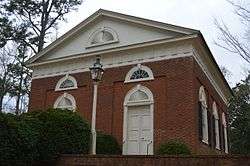Christ Church Glendower
|
Christ Church Glendower | |
 Front and northern side | |
  | |
| Location | On VA 713, 0.4 miles (0.64 km) southwest of the junction with VA 712, Keene, Virginia |
|---|---|
| Coordinates | 37°51′11″N 78°32′3″W / 37.85306°N 78.53417°WCoordinates: 37°51′11″N 78°32′3″W / 37.85306°N 78.53417°W |
| Area | 10 acres (4.0 ha) |
| Built | 1831 |
| Architect | William B. Phillips; Johnson, Craven, and Gibson |
| Architectural style | Early Republic, Roman Revival |
| NRHP reference # | 71000974[1] |
| VLR # | 002-0014 |
| Significant dates | |
| Added to NRHP | July 2, 1971 |
| Designated VLR | March 2, 1971[2] |
Christ Church Glendower, also known as Christ Church, St. Anne's Parish, is a historic Episcopal church located at Keene, Albemarle County, Virginia. It was built in 1831, and is a one-story, temple form, brick structure in the Roman Revival style. It features a full Doric order entablature with pediments at each end containing lunette windows. Surrounding the church is a contributing cemetery.[3]
History
In the second-quarter of the 18th century, European settlement following the James River expanded into the area which today comprises Albermarle County. In 1745, Albermarle County was formally chartered and a new parish of the established Church of England called St. Anne’s Parish was formed. The first three churches of St. Anne’s Parish were built prior to the American Revolutionary War, though at least one of them shifted to a new parish as population growth in the region led to the formation of new counties and parishes. All of the churches in St. Anne’s Parish ceased to function in 1784 when the Anglican Church was disestablished in Virginia.[4]
Around 1820, efforts to restore Episcopal worship in St. Anne’s Parish took root. Services were conducted in one of the remaining churches from the original parish until it was destroyed by fire. In 1831, the parish vestry resolved to erect a new brick church near Glendower which would be named Christ Church. Documents from the parish records refer to the architect for the church being a “Mr. Phillips.” Historical research asserts that this “Mr. Phillips” was William B. Phillips, a mason who was employed by Thomas Jefferson and helped to build the University of Virginia in Charlottesville. His design for Christ Church reflects the classical influences of Thomas Jefferson’s architecture (as seen in the University of Virginia and his residence, Monticello). Christ Church was completed in 1832 and consecrated on June 28, 1832 by Bishop William Meade.[5]
In the years after Christ Church was built, two additional churches were constructed in St. Anne’s Parish. These churches are St. John’s Episcopal Church in Scottsville and St. Stephen’s Episcopal Church in Esmont. In 1971, Christ Church was added to the National Register of Historic Places in recognition of its architectural integrity as an example of Jeffersonian neoclassical design.[1]
References
- 1 2 National Park Service (2009-03-13). "National Register Information System". National Register of Historic Places. National Park Service.
- ↑ "Virginia Landmarks Register". Virginia Department of Historic Resources. Retrieved 2013-05-12.
- ↑ Calder Conrad Loth (February 1971). "National Register of Historic Places Inventory Nomination Form: Christ Church Glendower" (PDF). Commonwealth of Virginia, Department of Historic Resources. and Accompanying photo
- ↑ "Historic American Buildings Survey: Christ Church Glendower" (PDF). Library of Congress. Library of Congress. Retrieved 24 May 2017.
- ↑ "Historic American Buildings Survey: Christ Church Glendower" (PDF). Library of Congress. Library of Congress. Retrieved 24 May 2017.
External links
- Christ Church (Episcopal), State Routes 713 & 712, Glendower, Albemarle County, VA: 8 measured drawings and 13 data pages at Historic American Buildings Survey

